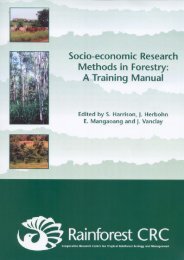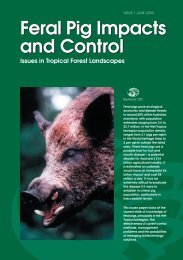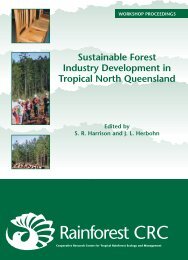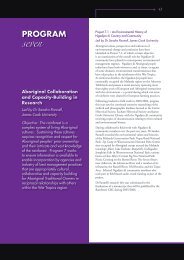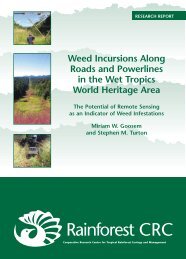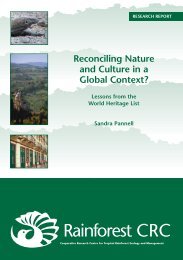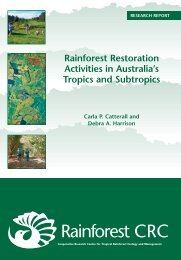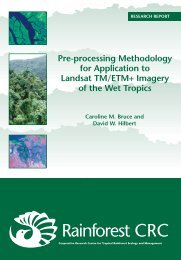S<strong>and</strong>ra Pannellru<strong>in</strong>s to symbolise Macau not just as a World Heritage site, but as an area <strong>in</strong> its own right.For example, at the open<strong>in</strong>g ceremony of the 4 th East Asia Games on the 29 October 2005,an illum<strong>in</strong>ated <strong>and</strong> larger-than-life reproduction of St Paul’s Ru<strong>in</strong>s formed the centrepiece ofthe celebrations <strong>and</strong> ‘the dazzl<strong>in</strong>g displays” (Macau Sunday Morn<strong>in</strong>g Post 30 October 2005).Notwithst<strong>and</strong><strong>in</strong>g the religious history of the ru<strong>in</strong>s, <strong>and</strong> present-day signs rem<strong>in</strong>d<strong>in</strong>g visitors ofthis association, it is clear that this Catholic edifice has been secularised <strong>in</strong> the service of theMacau tourism <strong>in</strong>dustry. It thus represents a form of ‘neutral’ urban space, stripped of thetraditional conventions <strong>and</strong> observances associated with the h<strong>and</strong>ful of ‘work<strong>in</strong>g’ churches<strong>and</strong> chapels with<strong>in</strong> the World Heritage area. While some of these churches still function asplaces of worship, most have been transformed <strong>in</strong>to religious museums <strong>and</strong> touristattractions (Figure 17). This apparent secularisation of religious places is perhaps areflection of the fact that today less than five percent of the 490,000 people who <strong>in</strong>habit thepen<strong>in</strong>sula identify as Catholics (Macau Government Tourist Office 2002). The Catholiclegacy of the Portuguese is thus more readily apparent <strong>in</strong> the many heritage classifiedchapels <strong>and</strong> churches that comprise the Historic Centre of Macau, than it is <strong>in</strong> thecontemporary religious observances of the local population.While the Macau Government Tourist Office identifies the Historic Centre of Macau as a“liv<strong>in</strong>g representation of the city’s historic settlement” (Macau Government Tourist Office2005: 2), this representation is dom<strong>in</strong>ated by a monument-based vision of cultural heritage.This focus upon ‘qua<strong>in</strong>t old build<strong>in</strong>gs’ functions to distract visitors to the Historic Centre fromquestion<strong>in</strong>g or pursu<strong>in</strong>g the other histories hidden beh<strong>in</strong>d these facades. Like so many otherlisted historic centres, Macau “offers the perfection of the restoration as a remedy for theimperfections of the past” (Kirshenblatt-Gimblett 1998: 9).While not a ‘historic centre’ itself, recent events at the World Heritage site of Stonehengeepitomise the way restoration, driven by ideas about authenticity <strong>and</strong> <strong>in</strong>tegrity, attempts toconceal the imperfections of the past. Listed <strong>in</strong> 1986, the megaliths of Stonehenge <strong>and</strong>Avebury, together with a number of associated Neolithic sites, are surrounded by theaccretions of more than five thous<strong>and</strong> years of human history. Over the centuries, some ofthe stones of the Stonehenge monument have fallen down, others have been carried away tobe used for build<strong>in</strong>g purposes or to repair farm tracks, while visitors to the site have effectedtheir own modifications. As stated on the English Heritage website, <strong>in</strong> the recent past “it wasquite normal to hire a hammer from the blacksmith <strong>in</strong> Amesbury <strong>and</strong> come to Stonehenge tochip bits off”. A similar fate befell the stones compris<strong>in</strong>g the circle of Avebury. Many of thesestones were broken down dur<strong>in</strong>g the seventeenth century to use as build<strong>in</strong>g materials for theexpansion of the village. As these observations <strong>in</strong>dicate, the material forms we identify asStonehenge <strong>and</strong> Avebury today are the products of quite varied historical use. This usereflects the shift<strong>in</strong>g significance accorded these two stone complexes by local communities <strong>in</strong>the past. It also reflects the fact that the idea of heritage, <strong>and</strong> the associated ethos ofpreservation, is a recent phenomenon. As Lord Chorley, Chairman of The National Trust forPlaces of Historic Interest or Natural Beauty, observes:Until the twentieth century, the survival of these monuments [Brita<strong>in</strong>’s WorldHeritage sites] <strong>in</strong> the face of Vik<strong>in</strong>g <strong>in</strong>vasions, civil war, enemy bombardment,periods of rapid <strong>in</strong>dustrial development <strong>and</strong> profound demographic change,has been largely a matter of chance (1992: 356).Perhaps nowhere else <strong>in</strong> the United K<strong>in</strong>gdom is this observation most apparent than atStonehenge (Figure 18a). Today, Stonehenge st<strong>and</strong>s <strong>in</strong> a sheep paddock criss-crossed withfences <strong>and</strong> hemmed <strong>in</strong> by two major roads, the A303 <strong>and</strong> the A344 (Figure 18b), while thestone circle of Avebury is enclosed with<strong>in</strong> a village dat<strong>in</strong>g back to Saxon times, <strong>and</strong> likeStonehenge, is surrounded by roads <strong>and</strong> traffic. In 1993, the British Parliament’s House ofCommons Public Accounts Committee described the situation at Stonehenge as ‘a nationaldisgrace’. Respond<strong>in</strong>g to political outcry <strong>and</strong> public concern, the 2000 Stonehenge World54
<strong>Reconcil<strong>in</strong>g</strong> <strong>Nature</strong> <strong>and</strong> <strong>Culture</strong> <strong>in</strong> a <strong>Global</strong> <strong>Context</strong>?Lessons from the World Heritage ListHeritage Site Management Plan outl<strong>in</strong>es a strategy to “conserve <strong>and</strong> manage the site forfuture generations” (English Heritage website 2006). Known as the ‘Stonehenge Project’,this program of remedial action will “rescue this iconic World Heritage Site from the noise <strong>and</strong>clutter of the twenty-first century <strong>and</strong> give it the dignified sett<strong>in</strong>g it deserves” (TheStonehenge Project website 2006). The ‘restoration’ of Stonehenge will remove exist<strong>in</strong>groads, return ploughed fields to a “green <strong>and</strong> pleasant l<strong>and</strong>scape” of open grassl<strong>and</strong>,recreate the conditions for improved biodiversity <strong>and</strong> a “wide variety of wildlife”, <strong>and</strong> ‘reunite’Stonehenge <strong>and</strong> its surround<strong>in</strong>g monuments <strong>in</strong> their ‘natural’ chalk downl<strong>and</strong> l<strong>and</strong>scapesett<strong>in</strong>g (The Stonehenge Project website 2006). In restor<strong>in</strong>g Stonehenge to its ‘splendidisolation’, the Stonehenge Project aims to recreate the ceremonial l<strong>and</strong>scape of the Neolithicera, thus enabl<strong>in</strong>g visitors to “fully appreciate Stonehenge’s dramatic l<strong>and</strong>scape sett<strong>in</strong>g”(English Heritage website 2006). This restoration process will also erase much of theprevious human activities <strong>and</strong> achievements that have shaped <strong>and</strong> formed the l<strong>and</strong>scape wesee today. With an emphasis upon pure <strong>and</strong> orig<strong>in</strong>al forms as a measure of authenticity, it isapparent that these elements of the past do not constitute a heritage worth protect<strong>in</strong>g orpreserv<strong>in</strong>g for future generations. The proposed <strong>in</strong>terventions at Stonehenge reflect agrow<strong>in</strong>g trend <strong>in</strong> the production of heritage where experts <strong>and</strong> agencies attempt to rectify theerrors of the past. Increas<strong>in</strong>gly, visitors travel to World Heritage sites to experience aheritage production that is actually better than “the historical actuality it represents”(Kirshenblatt-Gimblett 1998: 8). As we see with the example of the Historic Centre of Macau,<strong>and</strong> many other listed properties where heritage realism is produced, tourists can now travelto an actual dest<strong>in</strong>ation <strong>and</strong> experience the virtual place of a colonial past.In official texts the colonial encounter <strong>in</strong> Macau is presented as a sanitised series of richcultural exchanges <strong>and</strong> productive trade <strong>in</strong>teractions. Government tourist literaturespecifically identifies the so-called ‘<strong>in</strong>tangible’ outcomes of this “spontaneous blend ofdifferent cultures” (ICOMOS 2005a: 61) as ‘religious tolerance’, ‘cuis<strong>in</strong>e which is a fusion ofcul<strong>in</strong>ary traditions’, <strong>and</strong> the development of the Creole language Macquista. There is nosuggestion <strong>in</strong> any of the <strong>in</strong>terpretive material produced by the Macau Government TouristOffice that the arrival of the Portuguese, <strong>and</strong> the ensu<strong>in</strong>g colonial experience <strong>in</strong> the ‘City ofthe Name of God <strong>in</strong> Ch<strong>in</strong>a’, <strong>in</strong>volved acts of atrocities, religious persecution, or the usualforms of oppression associated with the expansion of the Portuguese sea-borne empire <strong>in</strong>other parts of Asia (Boxer 1969), such as Goa <strong>and</strong> Malacca, referred to <strong>in</strong> the nom<strong>in</strong>ationdocuments as ‘relevant sites of comparison’. As Boxer po<strong>in</strong>ts out, ‘religious conversion’ <strong>in</strong>the Asian outposts of the Portuguese empire was often at the po<strong>in</strong>t of a sword, or when not<strong>in</strong>volv<strong>in</strong>g physical violence, certa<strong>in</strong>ly <strong>in</strong>volved “discrim<strong>in</strong>atory <strong>and</strong> coercive measures” (1969:68).This silence about some of the less picturesque forms of colonial impact is also evident <strong>in</strong> anumber of UNESCO-sponsored publications on ‘cultural l<strong>and</strong>scapes’. Once aga<strong>in</strong> ‘colonialcultural heritage’ is reduced to “chapels <strong>and</strong> churches” (Mujica 2003: 85), <strong>and</strong> is thus notregarded as one of the ‘challenges of conservation’. Or, alternatively, it is not evenmentioned at all (Droste et al. 1995). As Hernández Llosas po<strong>in</strong>ts out, the ‘church <strong>and</strong>chapel’ view of heritage <strong>in</strong> places like Lat<strong>in</strong> America <strong>and</strong> Asia not only restricts our read<strong>in</strong>g ofthe legacy of colonialism, but it also serves to elevate this period as “the local past, history<strong>and</strong> heritage” (2004: 148). Elements of this process are evident <strong>in</strong> the way that history <strong>and</strong>heritage are construed <strong>in</strong> the Historic Centre of Macau. While the A-Ma Temple isacknowledged <strong>in</strong> the nom<strong>in</strong>ation document <strong>and</strong> tourist brochures as exist<strong>in</strong>g prior to thearrival of the Portuguese, <strong>in</strong> the official history of the Historic Centre of Macau, Ch<strong>in</strong>eseculture is portrayed as tak<strong>in</strong>g a historical back seat to the monumental achievements of thecolonists, until at least the onset of the twentieth century (see ICOMOS 2005a: 59).This last po<strong>in</strong>t once aga<strong>in</strong> br<strong>in</strong>gs us back to the questions of “what is heritage all about…[<strong>and</strong>] whose heritage is it?” (Hernández Llosas 2004: 148). As some commentators on thepolitics of World Heritage have noted, “often the ways <strong>in</strong> which [a] community values the55




